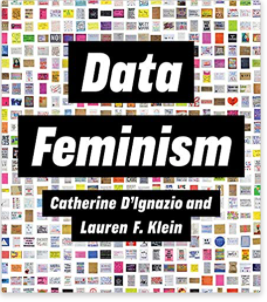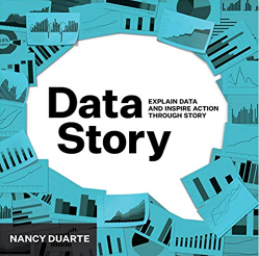Data Visualization Quotes
- poprebeca
- Oct 28, 2020
- 5 min read
...from books and people that have inspired me
I'm an avid reader. I have a collection of over 30 books, ranging from data visualization literacy to data storytelling. In fact, nothing gets me more excited than being somewhere in nature, sipping coffee (yes, I am a big coffee drinker!), and reading a data visualization book.
All my books are packed with post-it notes and I typically underline my favorite paragraphs directly on the page. Over time, I've accumulated a ton of quotes that I like to go back to whenever I am looking for inspiration.
In this blog post, I am going to share with you some of my favorite quotes. I hope that you'll feel inspired to learn more about data literacy, data visualization, and data storytelling.
Learn more about our virtual data storytelling and visualization training for your team!
Data Understanding & Data Literacy
Data understanding and data literacy are critical skills to anyone visualizing data. If you don't accurately understand the data that you work with, you risk misleading your audience. So, before you start exploring the fields of data visualization and data storytelling, I suggest starting with data understanding and data literacy. Here are some of my favorite quotes, with links to the sources.
Ben Jones, Avoiding Data Pitfalls:
"But when is a given data set clean enough? Like a kitchen countertop, it can always be cleaner. We hit a point of diminishing returns in our preparation of any data set, though, where more elbow grease and scrubbing doesn’t yield sufficient incremental benefit to warrant the time and effort."
Catherine D'Ignazio and Lauren F. Klein, Data Feminism:
"Data feminism begins by examining how power operates in the world today. This consists of asking who questions about data science: Who does the work (and who is pushed out)? Who benefits (and who is neglected or harmed)? Whose priorities get turned into products (and whose are overlooked)? These questions are relevant at the level of individuals and organizations, and are absolutely essential at the level of society."
Alberto Cairo, The Truthful Art:
"Helping people tell bullshit from facts should certainly be a duty for all journalists and information designers. Whenever we get information from anyone, we have to make sure that it's reliable, to the extent of our knowledge and analytical skills. We need to ask our sources: how do you know? And moreover: how do you know that you know?, as that will force them to disclose the methods and data used to reach their conclusions."
Giorgia Lupi and Stefanie Posavec, Dear Data:
"Besides finding data in the world around us, we are all creating data just by living: our purchases, our movements through the city, our explorations across the internet, all contribute to the 'data trail' we leave in our walk as we move through life."
Hans Rosling, Factfulness:
"Never leave a number all by itself. Never believe that one number on its own can be meaningful. If you are offered one number, always ask for at least one more. Something to compare it with."
Data Visualization
Data visualization should always stand on the shoulders of data understanding and data literacy. Once you have an accurate understanding of the data, you can start considering questions such as: "What chart should I choose?" or "What color should I use?" or "How will my audience perceive the visualizations?"
With these questions in mind, here are some of my favorite data visualization quotes related to design and perception:
Cole Nussbaumer Knaflic, Storytelling with Data:
"What do you need your audience to know or do? This is the point where you think through how to make what you communicate relevant for your audience and form a clear understanding of why they should care about what you say."
William Cleveland, Visualizing Data:
"No matter how clever the choice of the information, and no matter how technologically impressive the encoding, a visualization fails if the decoding fails."
John Tukey, Exploratory Data Analysis:
"The greatest value of a picture is when it forces us to notice what we never expected to see."
Edward Tufte, The Visual Display of Quantitative Information:
"Just as a good editor of prose ruthlessly prunes out unnecessary words, so a designer of statistical graphics should prune out ink that fails to present fresh data-information. Although nothing can replace a good graphical idea applied to an interesting set of numbers, editing and revision are as essential to sound graphical work as they are to writing."
Colin Ware, Visual Thinking for Design:
"One reason design is difficult is that the designer already has the knowledge expressed in the design, has seen it develop from inception, and therefore cannot see it with fresh eyes. The solution is to be analytic and this is where this book is intended to add value. Effective design should start with a visual task analysis, determine the set of visual queries to be supported by a design, and then use color, form, and space to efficiently serve those queries."
Stephen Few, Show Me the Numbers:
"With a basic understanding of visual perception, we can build a set of visual design principles, begin with those that apply equally to tables and graphs. Our primary visual design objectives will be to present content to readers in a manner that highlights what's important, arranges it for clarity, and leads them through it in the sequence that tells the story best."
Data Storytelling
A quick Google search reveals over 125 million results for the terms "data storytelling." It is a skill that a large number of professionals are working to acquire. I've already written two blog posts on data storytelling: here and here.
I hope that the quotes below will spark your curiosity and will provide some food for thought.
RJ Andrews, Info We Trust:
"To harness data, the world needs information: more information, better information, more complex and more nuanced understanding, and better narratives that can show ways for all to flourish. […] To be a data storyteller is to be a creator, a maker, a constructor. We do not just make information, but new and enthusiastic visions of how things are and how they might be."
Nancy Duarte, Data Story:
"As you explore data, you'll begin to formulate thoughts about what it's telling you. A point of view will emerge from the deep thinking. Sometimes, what you've uncovered will be blatantly self-evident to everyone and based 100 percent on the data. Sometimes, you will have to use a pinch of intuition and make some assumptions. Once you've taken a clear stance on what you've found, you're ready to construct a data point of view (DataPOV)."
Kindra Hall, Stories that Stick:
"Another component that we believed was essential was the presence of authentic emotion. A list of events or occurrences does not make a great story. A static time line is not a story. The emotion doesn't have to be overly dramatic; it can be as simple or as common as frustration or wonder or curiosity. But it needs to be there."
David McCandless, TED Talk:
"There's something almost quite magical about visual information. It's effortless, it literally pours in. And if you're navigating a dense information jungle, coming across a beautiful graphic or a lovely data visualization, it's a relief, it's like coming across a clearing in the jungle."
If you're looking to learn more, I encourage you to pick up a few books on data understanding and data literacy, before continuing on to books on data visualization and data storytelling. This will ensure that you develop a 360-degree understanding of the field.
Note: I use affiliate links whenever possible (if you purchase items listed above using my affiliate links, I will get a bonus).


































Comments